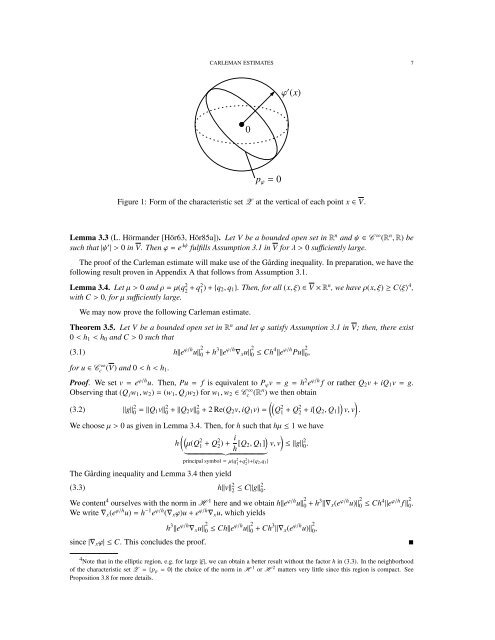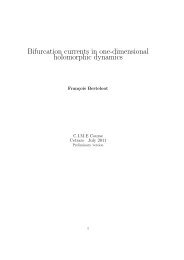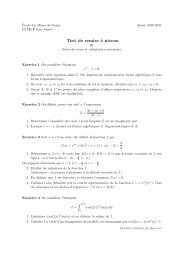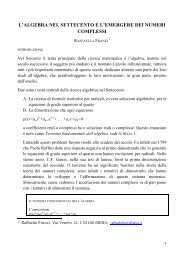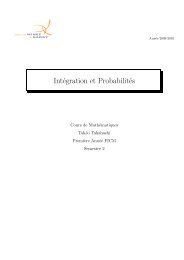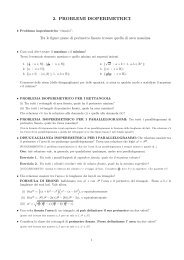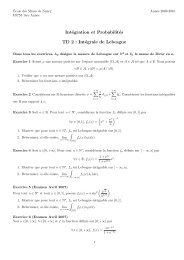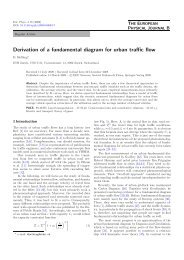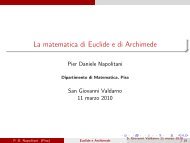on carleman estimates for elliptic and parabolic operators ...
on carleman estimates for elliptic and parabolic operators ...
on carleman estimates for elliptic and parabolic operators ...
You also want an ePaper? Increase the reach of your titles
YUMPU automatically turns print PDFs into web optimized ePapers that Google loves.
CARLEMAN ESTIMATES 7<br />
ϕ ′ (x)<br />
0<br />
p ϕ = 0<br />
Figure 1: Form of the characteristic set Z at the vertical of each point x ∈ V.<br />
Lemma 3.3 (L. Hörm<strong>and</strong>er [Hör63, Hör85a]). Let V be a bounded open set in R n <strong>and</strong> ψ ∈ C ∞ (R n , R) be<br />
such that |ψ ′ | > 0 in V. Then ϕ = e λψ fulfills Assumpti<strong>on</strong> 3.1 in V <strong>for</strong> λ > 0 sufficiently large.<br />
The proof of the Carleman estimate will make use of the Gårding inequality. In preparati<strong>on</strong>, we have the<br />
following result proven in Appendix A that follows from Assumpti<strong>on</strong> 3.1.<br />
Lemma 3.4. Let µ > 0 <strong>and</strong> ρ = µ(q 2 2 + q2 1 ) + {q 2, q 1 }. Then, <strong>for</strong> all (x, ξ) ∈ V × R n , we have ρ(x, ξ) ≥ C〈ξ〉 4 ,<br />
with C > 0, <strong>for</strong> µ sufficiently large.<br />
We may now prove the following Carleman estimate.<br />
Theorem 3.5. Let V be a bounded open set in R n <strong>and</strong> let ϕ satisfy Assumpti<strong>on</strong> 3.1 in V; then, there exist<br />
0 < h 1 < h 0 <strong>and</strong> C > 0 such that<br />
(3.1)<br />
h‖e ϕ/h u‖ 2 0 + h 3 ‖e ϕ/h ∇ x u‖ 2 0 ≤ Ch 4 ‖e ϕ/h Pu‖ 2 0,<br />
<strong>for</strong> u ∈ C ∞<br />
c (V) <strong>and</strong> 0 < h < h 1 .<br />
Proof. We set v = e ϕ/h u. Then, Pu = f is equivalent to P ϕ v = g = h 2 e ϕ/h f or rather Q 2 v + iQ 1 v = g.<br />
Observing that (Q j w 1 , w 2 ) = (w 1 , Q j w 2 ) <strong>for</strong> w 1 , w 2 ∈ Cc ∞ (R n ) we then obtain<br />
((<br />
(3.2) ‖g‖ 2 0 = ‖Q 1v‖ 2 0 + ‖Q 2v‖ 2 0 + 2 Re(Q 2v, iQ 1 v) = Q<br />
2<br />
1 + Q 2 2 + i[Q 2, Q 1 ] ) v, v)<br />
.<br />
We choose µ > 0 as given in Lemma 3.4. Then, <strong>for</strong> h such that hµ ≤ 1 we have<br />
((<br />
h µ(Q<br />
2<br />
1 + Q 2 2 ) + i h [Q 2, Q 1 ] ) )<br />
v, v ≤ ‖g‖ 2 0 .<br />
}{{}<br />
principal symbol = µ(q 2 1 +q2 2 )+{q 2,q 1 }<br />
The Gårding inequality <strong>and</strong> Lemma 3.4 then yield<br />
(3.3) h‖v‖ 2 2 ≤ C‖g‖2 0 .<br />
We c<strong>on</strong>tent 4 ourselves with the norm in H 1 here <strong>and</strong> we obtain h‖e ϕ/h u‖ 2 0 + h 3 ‖∇ x (e ϕ/h u)‖ 2 0 ≤ Ch 4 ‖e ϕ/h f ‖ 2 0.<br />
We write ∇ x (e ϕ/h u) = h −1 e ϕ/h (∇ x ϕ)u + e ϕ/h ∇ x u, which yields<br />
since |∇ x ϕ| ≤ C. This c<strong>on</strong>cludes the proof.<br />
h 3 ‖e ϕ/h ∇ x u‖ 2 0 ≤ Ch‖e ϕ/h u‖ 2 0 + Ch 3 ‖∇ x (e ϕ/h u)‖ 2 0,<br />
<br />
4 Note that in the <strong>elliptic</strong> regi<strong>on</strong>, e.g. <strong>for</strong> large |ξ|, we can obtain a better result without the factor h in (3.3). In the neighborhood<br />
of the characteristic set Z = {p ϕ = 0} the choice of the norm in H 1 or H 2 matters very little since this regi<strong>on</strong> is compact. See<br />
Propositi<strong>on</strong> 3.8 <strong>for</strong> more details.


